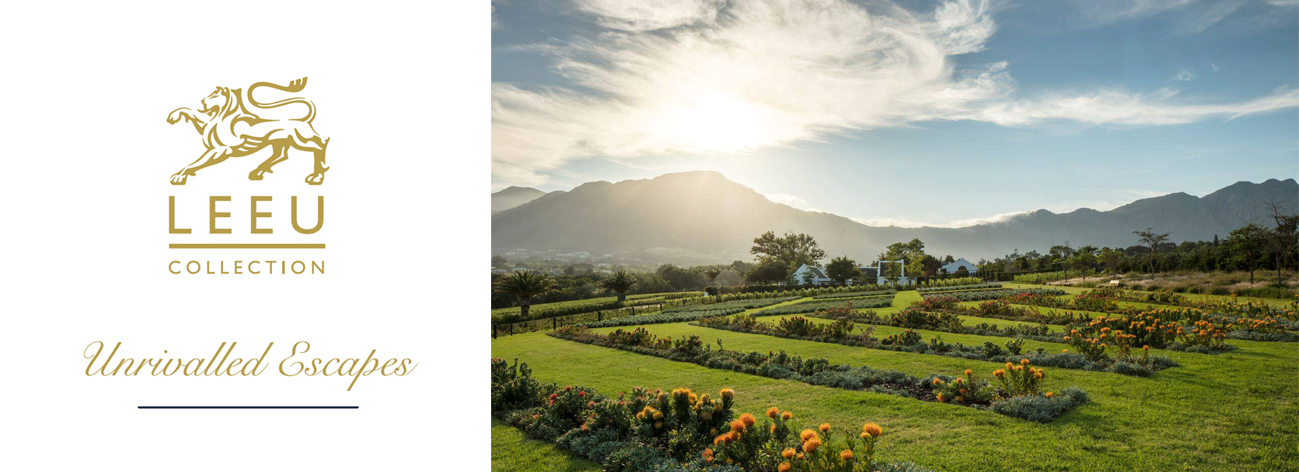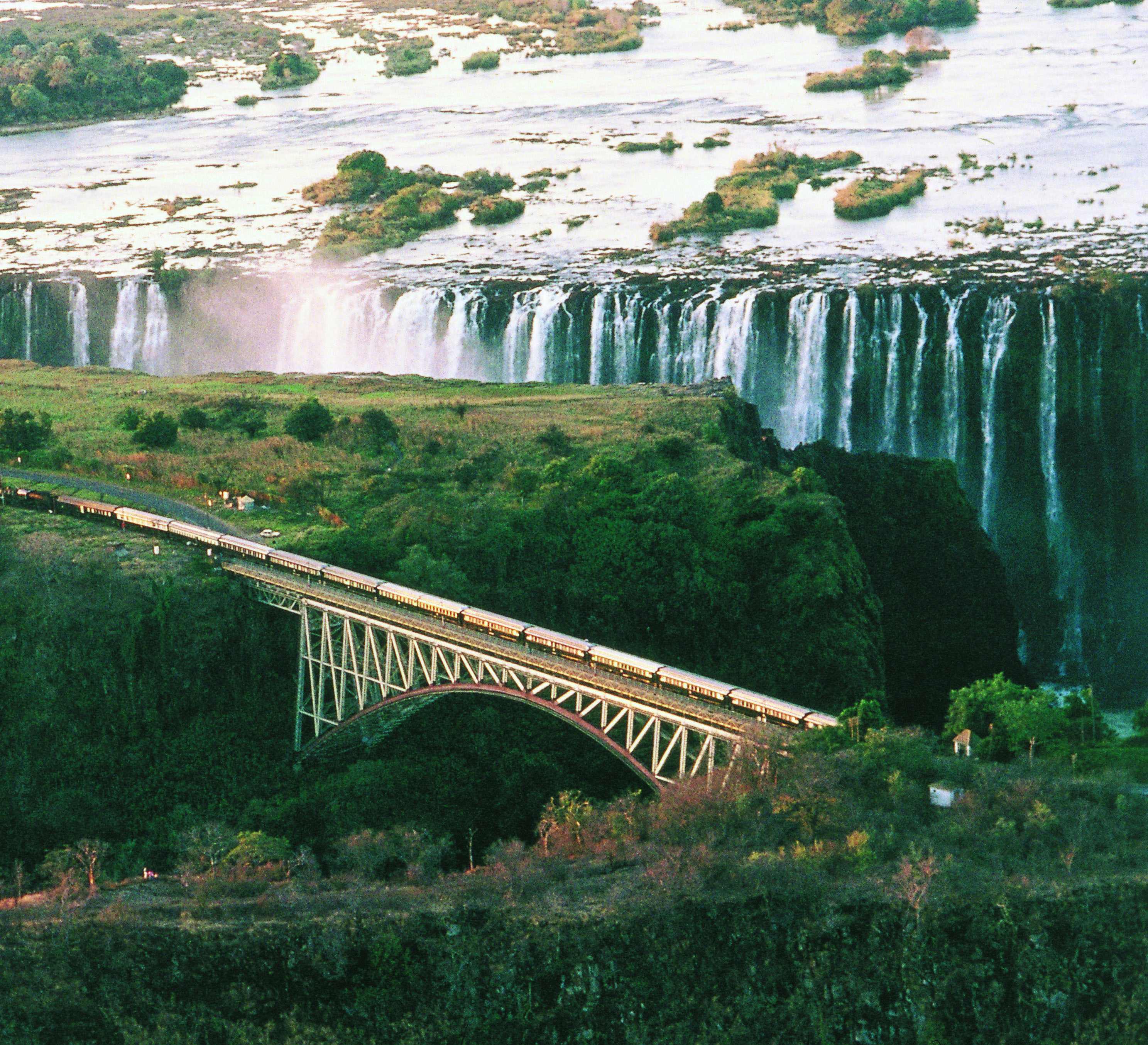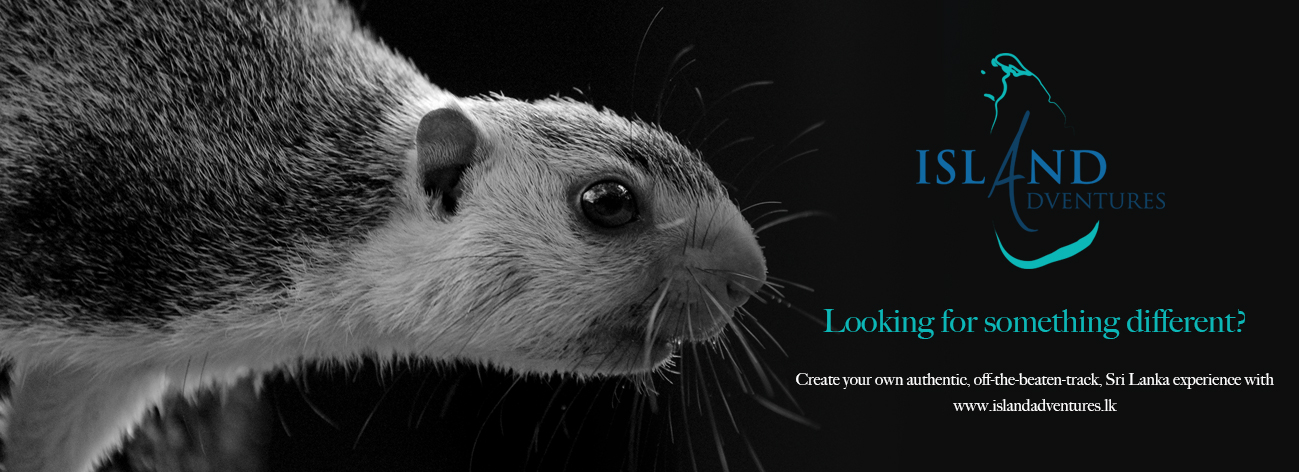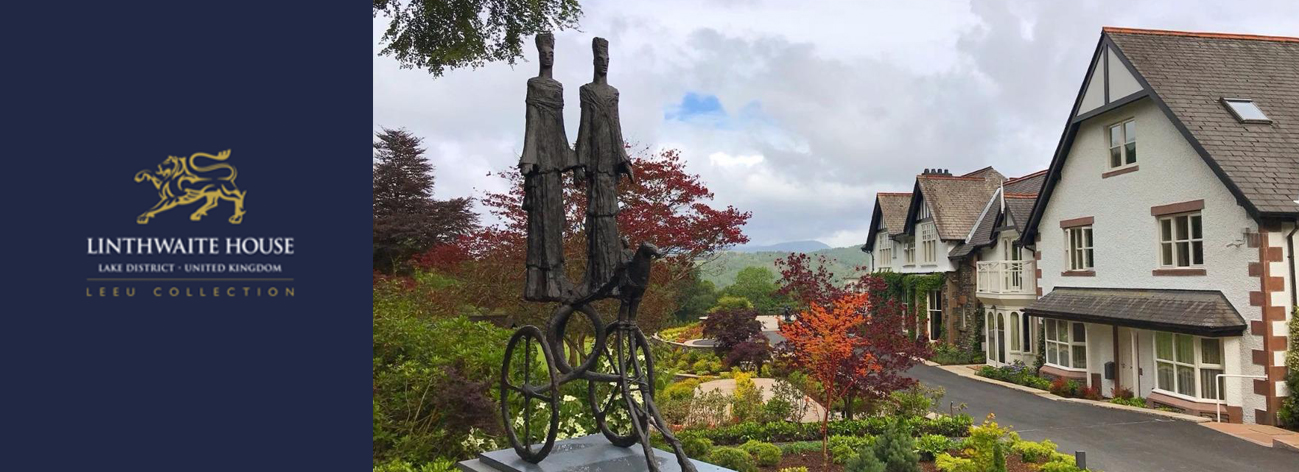TRAVEL
Surrey’s Premier Lifestyle Magazine
Count Nicholas
Kevin Pilley boards Rovos Rail’s Pride of Africa for a rail journey like no other and shares his luxurious trip with an eclectic collection of people.
The collective age on board the world’s most luxurious train journey was roughly 2,019. But Count Nicholas and resident hair stylist Craig pushed the grand total up well beyond three thousand. And the rest of the Rovos Rail staff upwards to four.
There were forty-six guests on the epic 3,568 mile, 15-day trip up the spine of Africa from Cape Town to Dar es Salaam via Botswana, Zimbabwe, Zambia and Tanzania. Rohan Vos, who made his money through auto parts, was determined to fulfil Cecil Rhodes’ dream of a line connecting the Mother City with Cairo. The Pride of Africa is Rovos Rail’s flagship route, running six times a year, and costing over £11,000 per head.
After a red carpet arrival, canapés and chamber music, Mr Vos personally waved us off from Cape Town’s Platform 23. For £1,100 per person a day, you get the finest South African food, wine and bottled water, 24/7 laundry, air conditioning, an open-balconied observation deck, two lounges with wingback chairs and sofas, a smoking lounge, clawfoot bathtubs or en suite showers, complimentary biltong, tea and coffee, gateaux and three-tier cake stands, top-of-the-range, select and very ‘Instagrammable’ toilet rolls, sparkling wine, welcoming moist towelettes returning from off-train excursions, an executive chef, two chefs, ten waiters, personal maids, discreet bodyguards and all the visas and border formalities sorted.
As well as a pair of goggles. So you can stick your head out of the train. Tunnels permitting.
Thrown in is a tour of the Kimberley Diamond Mine; two nights and four day/night game drives at the Botswana border Tau Lodge at the 170km perimeter fence Makidwe Reserve where, at breakfast, you can be joined by an abluting elephant at the terrace waterhole; one night full board at the £900 B&B Victoria Falls Hotel (sleeved, collared shirts and closed shoes under chandeliers amidst colonial kitsch in the formal Livingstone Room dining hall); a sunset Zambezi cruise; the option of a bungee jump off the bridge and a day in the Selous Game Reserve famous for its big-maned lions and big tuskers.
And the chance to smell Lusaka.
Plus the opportunity to meet a former scaffolder from Bedford, a schoolmaster from Salisbury, two Russian lawyers and personal friends of the mayor of Moscow, several American doctors, a Swiss air ambulance nurse, a few CEOs, a South African nougat mogul (South Africans make up six per cent of guests) and a newly-married Japanese couple: professor of accounting and his bride, a former student. The professor learned to speak English in Barnet.
And last, but not least, you get a Count.
There were forty-six guests on the epic 3,568 mile, 15-day trip up the spine of Africa from Cape Town to Dar es Salaam via Botswana, Zimbabwe, Zambia and Tanzania. Rohan Vos, who made his money through auto parts, was determined to fulfil Cecil Rhodes’ dream of a line connecting the Mother City with Cairo. The Pride of Africa is Rovos Rail’s flagship route, running six times a year, and costing over £11,000 per head.
After a red carpet arrival, canapés and chamber music, Mr Vos personally waved us off from Cape Town’s Platform 23. For £1,100 per person a day, you get the finest South African food, wine and bottled water, 24/7 laundry, air conditioning, an open-balconied observation deck, two lounges with wingback chairs and sofas, a smoking lounge, clawfoot bathtubs or en suite showers, complimentary biltong, tea and coffee, gateaux and three-tier cake stands, top-of-the-range, select and very ‘Instagrammable’ toilet rolls, sparkling wine, welcoming moist towelettes returning from off-train excursions, an executive chef, two chefs, ten waiters, personal maids, discreet bodyguards and all the visas and border formalities sorted.
As well as a pair of goggles. So you can stick your head out of the train. Tunnels permitting.
Thrown in is a tour of the Kimberley Diamond Mine; two nights and four day/night game drives at the Botswana border Tau Lodge at the 170km perimeter fence Makidwe Reserve where, at breakfast, you can be joined by an abluting elephant at the terrace waterhole; one night full board at the £900 B&B Victoria Falls Hotel (sleeved, collared shirts and closed shoes under chandeliers amidst colonial kitsch in the formal Livingstone Room dining hall); a sunset Zambezi cruise; the option of a bungee jump off the bridge and a day in the Selous Game Reserve famous for its big-maned lions and big tuskers.
And the chance to smell Lusaka.
Plus the opportunity to meet a former scaffolder from Bedford, a schoolmaster from Salisbury, two Russian lawyers and personal friends of the mayor of Moscow, several American doctors, a Swiss air ambulance nurse, a few CEOs, a South African nougat mogul (South Africans make up six per cent of guests) and a newly-married Japanese couple: professor of accounting and his bride, a former student. The professor learned to speak English in Barnet.
And last, but not least, you get a Count.
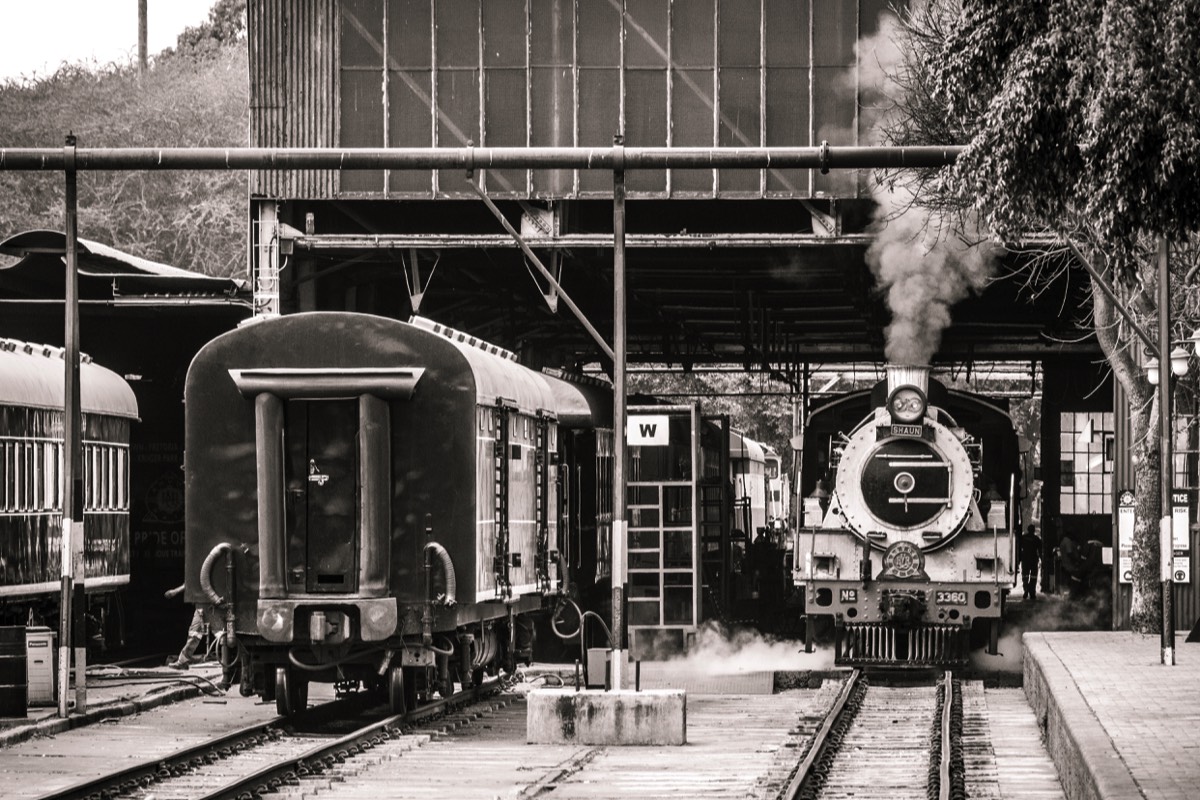
Site tour at Rovos Rail’s yard, Capital Park, Pretoria - Photo copyright: Thomas Ryan
All images are property of Rovos Rail Tours (Pty) Ltd except where indicated
All images are property of Rovos Rail Tours (Pty) Ltd except where indicated
Nicholas Schofield, whose grandfathers were from Bradford and the Isle of Man, has been the resident Rovos Rail historian for twenty-five years, clocking up over “450,000 clicks of clackety-clack.” He wears a rabbit fur safari hat with a self-designed zebra skin headband: “Like an Australian slouch hat, but not. Like one Churchill favoured. I have some available at $US75 plus P&P!”
He is called the Count because he counts guests out and counts them in from escorted tours of Pretoria and other excursions. He gives daily lectures where ‘The Big Six’ – yawning Swedes, sleeping Austrians, dozing French couples, napping Germans, catnapping Americans and hungover Brits are common sightings.
Meals are served in the refurbed, nearly a hundred-years-old, cherry-panelled, teakwood-pillared Belle Epoque restaurant with its ‘singing’ cut crystal wine glasses, starched linen napery, solid silver cutlery, tassel-tied curtains and romantic low lighting.
Menus include traditional South African Bobotie – spiced beef mince oven-baked with a layer of savoury egg custard, served with peppadew, kiwi fruit and banana chutney. Drunken Pecorino (ewe’s milk cheese soaked in a wine musk) precedes a dessert of melktert – a sweet pastry crust with a dusting of cinnamon served with fruit coulis – and a small syrup-coated South African doughnut known as a Koeksister.
The Pride of Africa also serves ostrich, croc tails and fillet of springbok with roasted sweet potatoes and black cherry compote. Chef Otto Hank’s signature dish is chocolate fondant. Amarula – made from the superfruit of the ‘elephant’ or ‘wedding tree’ – is a popular digestif. Says Otto: “It is excellent with ice and a great view.”
Cummerbunds, regimental uniforms, tiaras and national costumes are optional, but jacket and tie compulsory. Diners are hailed by a mini-xylophone. The gongs have gone. But the bygone days of rail travel are atmospherically recalled.
“The train is an institution,” says Schofield. “And a great social leveller. The group dynamics are fascinating. You see first impressions go spectacularly wrong. Stereotypes and preconceptions overturned. Elegant conversation is encouraged. Cellphone and laptop use discouraged.
“You are forced into conversation to survive. We have no casino. Or gym. Although the train doctor has an exercise bike, mainly for himself.”
The extraordinarily encyclopaedic and very personable Mr Schofield fields the questions. What do you call a group of zebras? A dazzle. A group of giraffes? A journey. Bump into him along the half-mile long, 21-carriage, jungle green and ivory train, give him a date and he won’t let you down.
1741? “Two years before the Battle of Dettingen. King George II was the last king to lead an army into battle.”
1502? “Da Gama was appointed first Portuguese viceroy of India. A title taken over by the British in 1858.”
He is called the Count because he counts guests out and counts them in from escorted tours of Pretoria and other excursions. He gives daily lectures where ‘The Big Six’ – yawning Swedes, sleeping Austrians, dozing French couples, napping Germans, catnapping Americans and hungover Brits are common sightings.
Meals are served in the refurbed, nearly a hundred-years-old, cherry-panelled, teakwood-pillared Belle Epoque restaurant with its ‘singing’ cut crystal wine glasses, starched linen napery, solid silver cutlery, tassel-tied curtains and romantic low lighting.
Menus include traditional South African Bobotie – spiced beef mince oven-baked with a layer of savoury egg custard, served with peppadew, kiwi fruit and banana chutney. Drunken Pecorino (ewe’s milk cheese soaked in a wine musk) precedes a dessert of melktert – a sweet pastry crust with a dusting of cinnamon served with fruit coulis – and a small syrup-coated South African doughnut known as a Koeksister.
The Pride of Africa also serves ostrich, croc tails and fillet of springbok with roasted sweet potatoes and black cherry compote. Chef Otto Hank’s signature dish is chocolate fondant. Amarula – made from the superfruit of the ‘elephant’ or ‘wedding tree’ – is a popular digestif. Says Otto: “It is excellent with ice and a great view.”
Cummerbunds, regimental uniforms, tiaras and national costumes are optional, but jacket and tie compulsory. Diners are hailed by a mini-xylophone. The gongs have gone. But the bygone days of rail travel are atmospherically recalled.
“The train is an institution,” says Schofield. “And a great social leveller. The group dynamics are fascinating. You see first impressions go spectacularly wrong. Stereotypes and preconceptions overturned. Elegant conversation is encouraged. Cellphone and laptop use discouraged.
“You are forced into conversation to survive. We have no casino. Or gym. Although the train doctor has an exercise bike, mainly for himself.”
The extraordinarily encyclopaedic and very personable Mr Schofield fields the questions. What do you call a group of zebras? A dazzle. A group of giraffes? A journey. Bump into him along the half-mile long, 21-carriage, jungle green and ivory train, give him a date and he won’t let you down.
1741? “Two years before the Battle of Dettingen. King George II was the last king to lead an army into battle.”
1502? “Da Gama was appointed first Portuguese viceroy of India. A title taken over by the British in 1858.”
Crossing the Victoria Falls Bridge
Follow him the length of the train and he will tell the story behind the cabin names – Mafeking, Baker (who designed Pretoria as well as Delhi) and Zulu chiefs like Dingaan and Shaka. You learn about Africa in comfort and security.
The first stop on the world’s most salubrious train journey is Matjiesfontein, venue in 1889 of the first cricket match between South Africa and England, who lost. On an eight-minute tour of the town on the fringe of the Karoo desert on a 1968 London double decker, Elvis impersonator and local pastor Johnny ‘Showtime’ Thennison took us to the Lord Milner Hotel, named after a Cape governor, and then played honky-tonk over a Kudu lager in the 130-year-old Laird’s Arms.
The town was used by TB suffers and as a military hospital and once stabled 10,000 horses. It contains the world’s largest private collection of Boer War memorabilia, including an impressive and very nostalgic array of turn-of-the-century commodes and chamber pots. Renalda the curator proudly introduced me to her 1890 stove and period steam irons.
At Pretoria’s Capital Park, you visit the Rovos yards where 100-year-old carriages are restored. The original steam locos from Birmingham and Glasgow were named after Vos family members. Running out of names, Rohan Vos named one Zog after his pet Dalmatian.
They make cameo appearances shunting the electric-locos into the yards. There is also a museum run by ex-driver Gert van Vuuren.
The first stop on the world’s most salubrious train journey is Matjiesfontein, venue in 1889 of the first cricket match between South Africa and England, who lost. On an eight-minute tour of the town on the fringe of the Karoo desert on a 1968 London double decker, Elvis impersonator and local pastor Johnny ‘Showtime’ Thennison took us to the Lord Milner Hotel, named after a Cape governor, and then played honky-tonk over a Kudu lager in the 130-year-old Laird’s Arms.
The town was used by TB suffers and as a military hospital and once stabled 10,000 horses. It contains the world’s largest private collection of Boer War memorabilia, including an impressive and very nostalgic array of turn-of-the-century commodes and chamber pots. Renalda the curator proudly introduced me to her 1890 stove and period steam irons.
At Pretoria’s Capital Park, you visit the Rovos yards where 100-year-old carriages are restored. The original steam locos from Birmingham and Glasgow were named after Vos family members. Running out of names, Rohan Vos named one Zog after his pet Dalmatian.
They make cameo appearances shunting the electric-locos into the yards. There is also a museum run by ex-driver Gert van Vuuren.
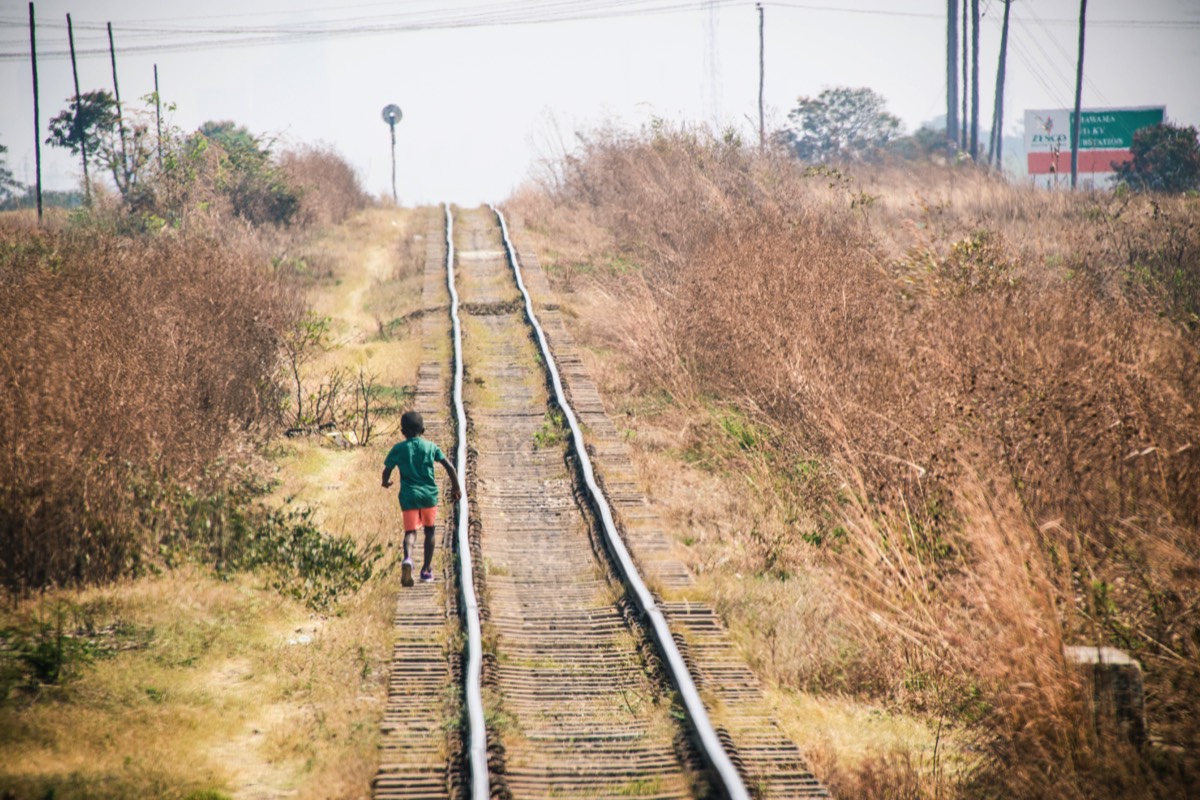
The Lusaka line, Zambia - Photo copyright: Thomas Ryan
Schofield lectured for “ten happy years” at Vista University, a black-only university in the Mamelodi township. “Now I can talk history all day long. And get paid for it,” he said.
He offers advice. “Don’t wear white and drink Pinotage when we are travelling through Zambia. And don’t have your hair done either. It’s pretty shaky!”
No-one was on the inaugural northbound run in 1993. But now Rovos – which runs luxury train hotel trips throughout southern Africa as well as into Namibia – is one of the most luxurious brands in the southern hemisphere. The ‘civilisation to wilderness’, Cape Town to Dar es Salaam trek is the flagship route.
We get to see a little-known part of Africa, a route barely travelled. My favourite part is between Makambako and Mimba where the train drops over 1,000m through matted jungle. On the Chinese Tazara line, you see the Udzungwa Mountains of Tanzania. The train brushes the side of the forest and you feel you can stretch out and touch the mountain. A rival to the Hex River Mountains outside Cape Town, glorious.
He offers advice. “Don’t wear white and drink Pinotage when we are travelling through Zambia. And don’t have your hair done either. It’s pretty shaky!”
No-one was on the inaugural northbound run in 1993. But now Rovos – which runs luxury train hotel trips throughout southern Africa as well as into Namibia – is one of the most luxurious brands in the southern hemisphere. The ‘civilisation to wilderness’, Cape Town to Dar es Salaam trek is the flagship route.
We get to see a little-known part of Africa, a route barely travelled. My favourite part is between Makambako and Mimba where the train drops over 1,000m through matted jungle. On the Chinese Tazara line, you see the Udzungwa Mountains of Tanzania. The train brushes the side of the forest and you feel you can stretch out and touch the mountain. A rival to the Hex River Mountains outside Cape Town, glorious.
“You are forced into conversation to survive. We have no casino. Or gym. Although the train doctor has an exercise bike, mainly for himself.”
